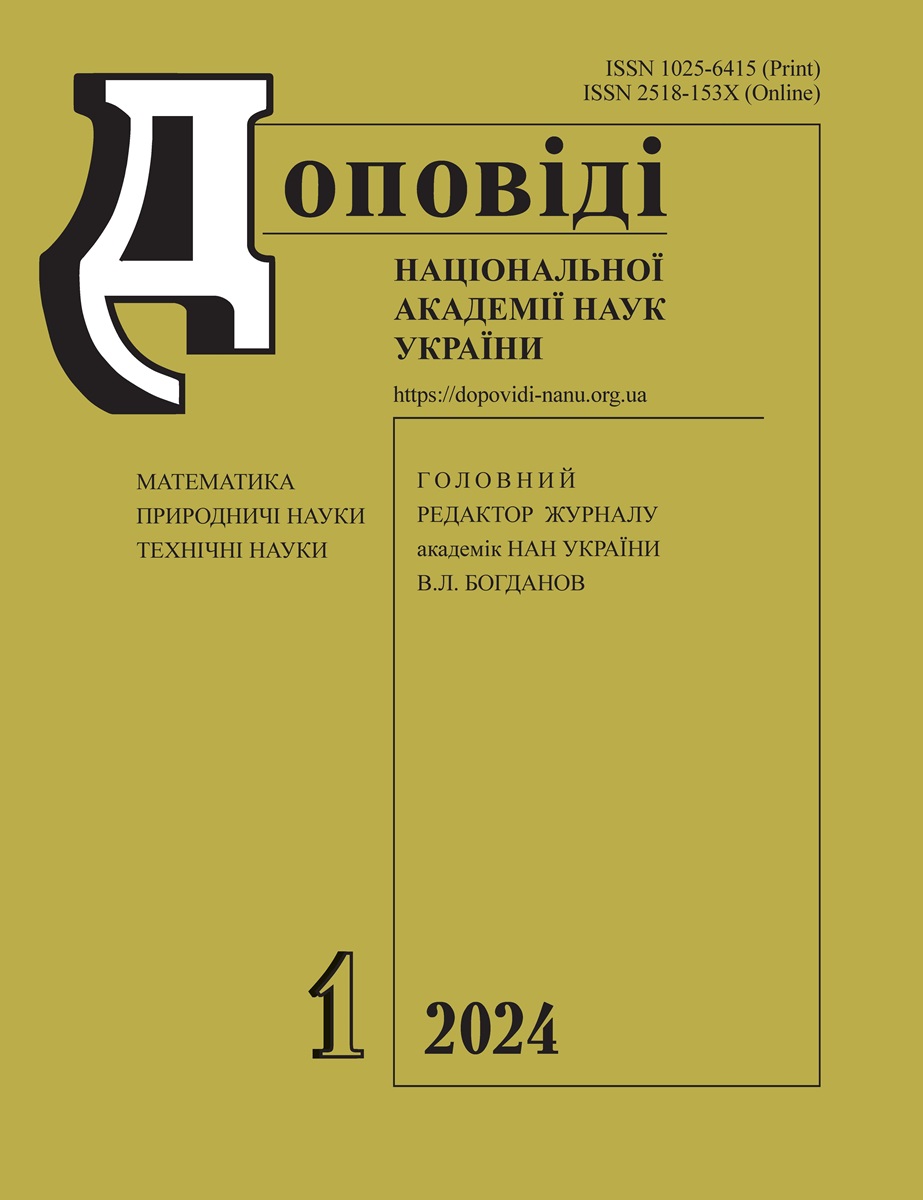Вплив адсорбованого метану на стан води в міжчастинкових зазорах метилкремнезему АМ-1
DOI:
https://doi.org/10.15407/dopovidi2024.01.064Ключові слова:
метан, адсорбція, гідратованість, гідрофобний кремнезем, гідрати метануАнотація
Методом низькотемпературної 1Н ЯМР-спектроскопії досліджекно будову адсорбційних комплексів води в міжчастинкових зазорах гідрофобного порошку метилкремнезему АМ-1 і вплив асоційованості води на формування гідратів метану. Показано, що зі збільшенням тривалості механічного оброблення зразка метилкремнезему частка слабоасоційованої води збільшується за рахунок зменшення кількості сильноасоційованої води. Порівняно адсорбційну ємність метилкремнезему і гідратів метану. Висунуто припущення, що поряд з рухливими гідратами метану на міжфазній межі АМ-1 формується певна кількість гідратів метану клатратного типу. Вони утворюються в рідкій воді шляхом розчинення в ній газоподібного метану. Оскільки як вода, так і метан, що входять до складу клатратів, не спостерігаються в спектрах рідинного ЯМР, одним з пояснень зменшення інтенсивності вузького сигналу однієї з форм сильноасоційованої води (WAW2) зі зниженням температури може бути зростання за цих умов кількості клатратних форм адсорбованого метану.
Завантаження
Посилання
Yaminsky, V. V. & Vogler, E. A. (2001). Hydrophobic hydration. Curr. Opin. Colloid Interface Sci., 6, pp. 342- 349. https://doi.org/10.1016/S1359-0294(01)00104-2
Chandler, D. (2005). Interfaces and the driving force of hydrophobic assembly. Nature, 437, pp. 640-647. https:// doi.org/10.1038/nature04162
Snyder, P. W., Lockett, M. R., Moustakas, D. T. & Whitesides, G. M. (2014). Is it the shape of the cavity, or the shape of the water in the cavity? Eur. Phys. J. Spec. Top., 223, pp. 853-889. https://doi.org/10.1140/epjst/e2013- 01818-y
Imai, T. & Hirata, F. (2005). Hydrophobic effects on partial molar volume. J. Chem. Phys., 122, 094509. https:// doi.org/10.1063/1.1854626
Mao, W. L., Mao, H.-k., Goncharov, A. F., Struzhkin, V. V., Gou, Q., Hu, J., Shu, J., Hemley, R. J., Somayazulu, M.
& Zhao, Y. (2002). Hydrogen clusters in clathrate hydrate. Science, 297, pp. 2247-2249. https://doi.org/10.1126/ science.1075394
Chou, I.-M., Sharma, A., Burruss, R. C., Shu, J., Mao, H.-k., Hemley, R. J., Goncharov, A. F., Stern, L. A. & Kirby, S. H. (2000). Transformations in methane hydrates. Proc. Natl. Acad. Sci. USA, 97, pp. 13484-13487. https://doi.org/10.1073/pnas.250466497
Somayazulu, M., Shu, J., Zha, C.-s., Goncharov, A. F., Tschauner, O., Mao, H.-k. & Hemley, R. J. (2008). In situ high-pressure x-ray diffraction study of H2O ice VII. J. Chem. Phys., 128, 064510. https://doi.org/ 10.1063/1.2813890
Gun’ko, V. M., Turov, V. V. & Krupska, T. V. (2018). Interfacial behavior of methane and organic solvents with low freezing points upon interaction with hydrophilic and hydrophobic nanosilicas. Him. Fiz. Tehnol. Pover- hni, 9, No. 2, pp. 107-123. https://doi.org/10.15407/hftp09.02.107
Gun’ko, V. M., Turov, V. V., Krupska, T. V. & Pakhlov, E. M. (2017). Behavior of water and methane bound to hydrophilic and hydrophobic nanosilicas and their mixture. Chem. Phys. Lett., 690, pp. 25-30. https://doi. org/10.1016/j.cplett.2017.10.039
Pat. 105151 UA, IPC В01J 2/10, The method of compaction of nanosilica, Krupska, T. V., Turov, V. V., Barvinchenko, V. N., Filatova, K. O., Suvorova, L. A. & Kartel, M. T., Publ. 10.03.2016 (in Ukrainian).
Krupskaya, T. V., Turov, V. V., Barvinchenko, V. M., Filatova, K. O., Suvorova, L. A., Iraci, G. & Kartel, M. T. (2017). Influence of the “wetting—drying” compaction on the adsorptive characteristics of nanosilica A-300. Adsorp. Sci. Technol., 36, pp. 300-310. https://doi.org/10.1177/0263617417691768
Gun’ko, V. M., Turov, V. V., Pakhlov, E. M., Krupska, T. V. & Charmas, B. (2018). Effect of water content on the characteristics of hydro-compacted nanosilica. Appl. Surf. Sci., 459, pp. 171-178. https://doi.org/10.1016/j. apsusc.2018.07.213
Gun’ko, V. M., Turov, V. V., Krupska, T. V. & Pakhlov, E. M. (2017). Behavior of water and methane bound to hydrophilic and hydrophobic nanosiliсas and their mixture. Chem. Phys. Lett., 690, pp. 25-30. https://doi. org/10.1016/j.cplett.2017.10.039
Gun’ko, V. M. & Turov, V. V. (2013). Nuclear magnetic resonance studies of interfacial phenomena. Boca Raton: CRC Press. https://doi.org/10.1201/b14202
Turov, V. V. & Gun’ko, V. M. (2011). Clustered water and ways of its use. Kiev: Naukova Dumka (in Russian).
Gun’ko, V. M., Turov, V. V., Bogatyrev, V. M., Zarko, V. I., Leboda, R., Goncharuk, E. V., Novza, A. A., Turov, A. V. & Chuiko, A. A. (2005). Unusual properties of water at hydrophilic/hydrophobic interfaces. Adv. Colloid Inter- face Sci., 118, pp. 125-172. https://doi.org/10.1016/j.cis.2005.07.003
##submission.downloads##
Опубліковано
Як цитувати
Номер
Розділ
Ліцензія
Авторське право (c) 2024 Доповіді Національної академії наук України

Ця робота ліцензується відповідно до Creative Commons Attribution-NonCommercial 4.0 International License.




